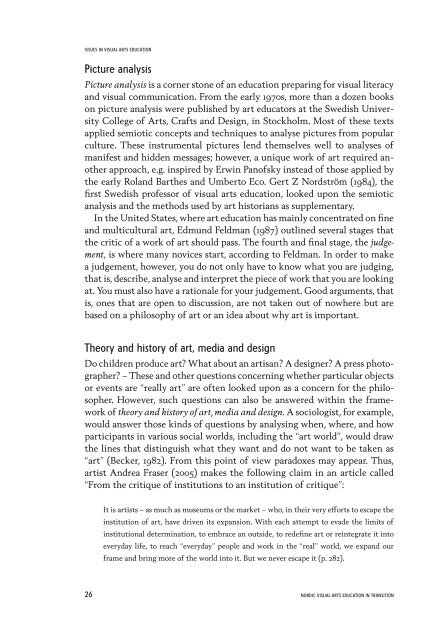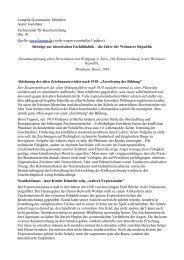Research in Visual Arts Education - The National Society for ...
Research in Visual Arts Education - The National Society for ...
Research in Visual Arts Education - The National Society for ...
Create successful ePaper yourself
Turn your PDF publications into a flip-book with our unique Google optimized e-Paper software.
ISSUES IN VISUAL ARTS EDUCATION<br />
Picture analysis<br />
Picture analysis is a corner stone of an education prepar<strong>in</strong>g <strong>for</strong> visual literacy<br />
and visual communication. From the early 1970s, more than a dozen books<br />
on picture analysis were published by art educators at the Swedish University<br />
College of <strong>Arts</strong>, Crafts and Design, <strong>in</strong> Stockholm. Most of these texts<br />
applied semiotic concepts and techniques to analyse pictures from popular<br />
culture. <strong>The</strong>se <strong>in</strong>strumental pictures lend themselves well to analyses of<br />
manifest and hidden messages; however, a unique work of art required another<br />
approach, e.g. <strong>in</strong>spired by Erw<strong>in</strong> Panofsky <strong>in</strong>stead of those applied by<br />
the early Roland Barthes and Umberto Eco. Gert Z Nordström (1984), the<br />
first Swedish professor of visual arts education, looked upon the semiotic<br />
analysis and the methods used by art historians as supplementary.<br />
In the United States, where art education has ma<strong>in</strong>ly concentrated on f<strong>in</strong>e<br />
and multicultural art, Edmund Feldman (1987) outl<strong>in</strong>ed several stages that<br />
the critic of a work of art should pass. <strong>The</strong> fourth and f<strong>in</strong>al stage, the judgement,<br />
is where many novices start, accord<strong>in</strong>g to Feldman. In order to make<br />
a judgement, however, you do not only have to know what you are judg<strong>in</strong>g,<br />
that is, describe, analyse and <strong>in</strong>terpret the piece of work that you are look<strong>in</strong>g<br />
at. You must also have a rationale <strong>for</strong> your judgement. Good arguments, that<br />
is, ones that are open to discussion, are not taken out of nowhere but are<br />
based on a philosophy of art or an idea about why art is important.<br />
<strong>The</strong>ory and history of art, media and design<br />
Do children produce art What about an artisan A designer A press photographer<br />
– <strong>The</strong>se and other questions concern<strong>in</strong>g whether particular objects<br />
or events are “really art” are often looked upon as a concern <strong>for</strong> the philosopher.<br />
However, such questions can also be answered with<strong>in</strong> the framework<br />
of theory and history of art, media and design. A sociologist, <strong>for</strong> example,<br />
would answer those k<strong>in</strong>ds of questions by analys<strong>in</strong>g when, where, and how<br />
participants <strong>in</strong> various social worlds, <strong>in</strong>clud<strong>in</strong>g the “art world”, would draw<br />
the l<strong>in</strong>es that dist<strong>in</strong>guish what they want and do not want to be taken as<br />
“art” (Becker, 1982). From this po<strong>in</strong>t of view paradoxes may appear. Thus,<br />
artist Andrea Fraser (2005) makes the follow<strong>in</strong>g claim <strong>in</strong> an article called<br />
“From the critique of <strong>in</strong>stitutions to an <strong>in</strong>stitution of critique”:<br />
It is artists – as much as museums or the market – who, <strong>in</strong> their very ef<strong>for</strong>ts to escape the<br />
<strong>in</strong>stitution of art, have driven its expansion. With each attempt to evade the limits of<br />
<strong>in</strong>stitutional determ<strong>in</strong>ation, to embrace an outside, to redef<strong>in</strong>e art or re<strong>in</strong>tegrate it <strong>in</strong>to<br />
everyday life, to reach “everyday” people and work <strong>in</strong> the “real” world, we expand our<br />
frame and br<strong>in</strong>g more of the world <strong>in</strong>to it. But we never escape it (p. 282).<br />
26 NORDIC VISUAL ARTS EDUCATION IN TRANSITION



